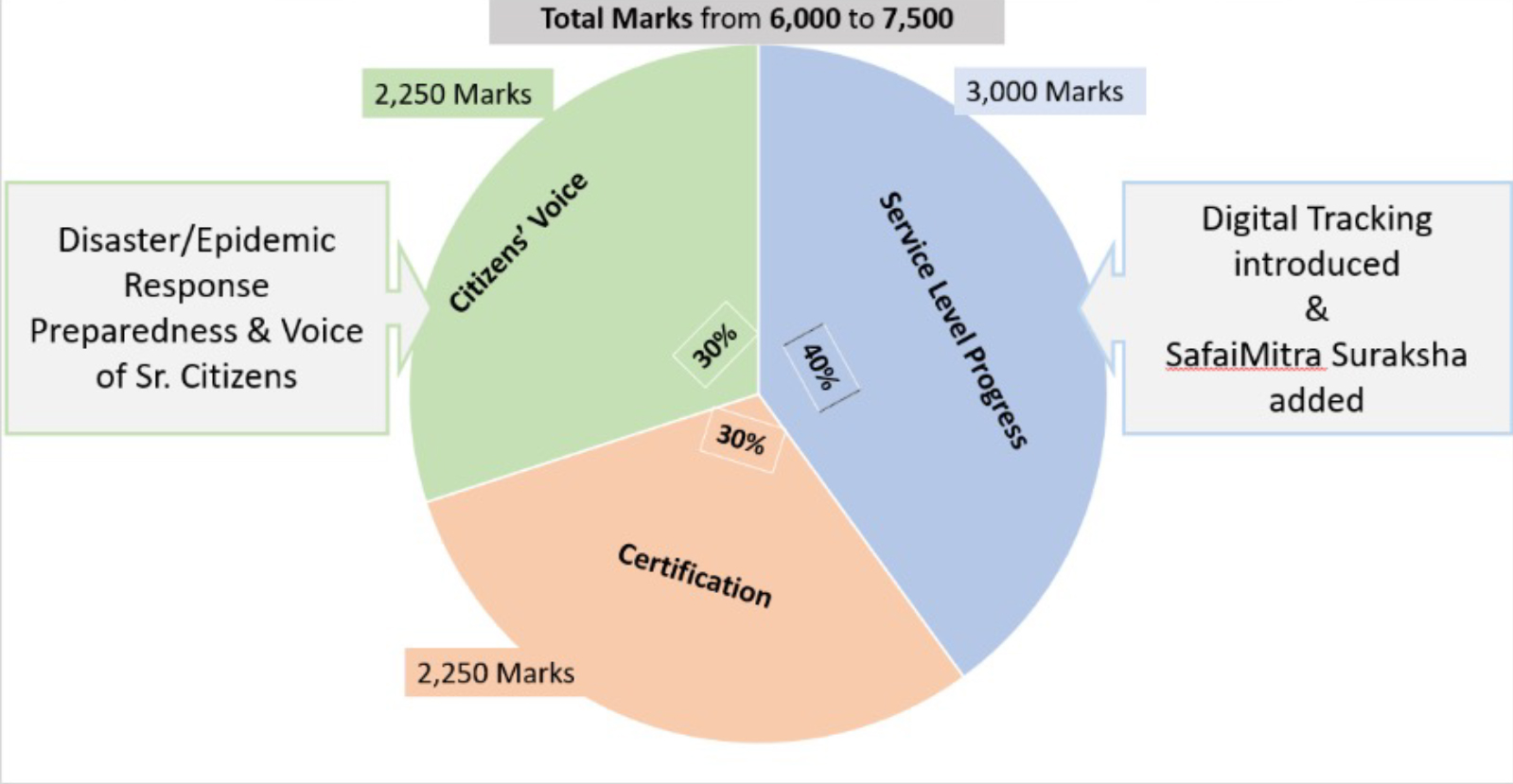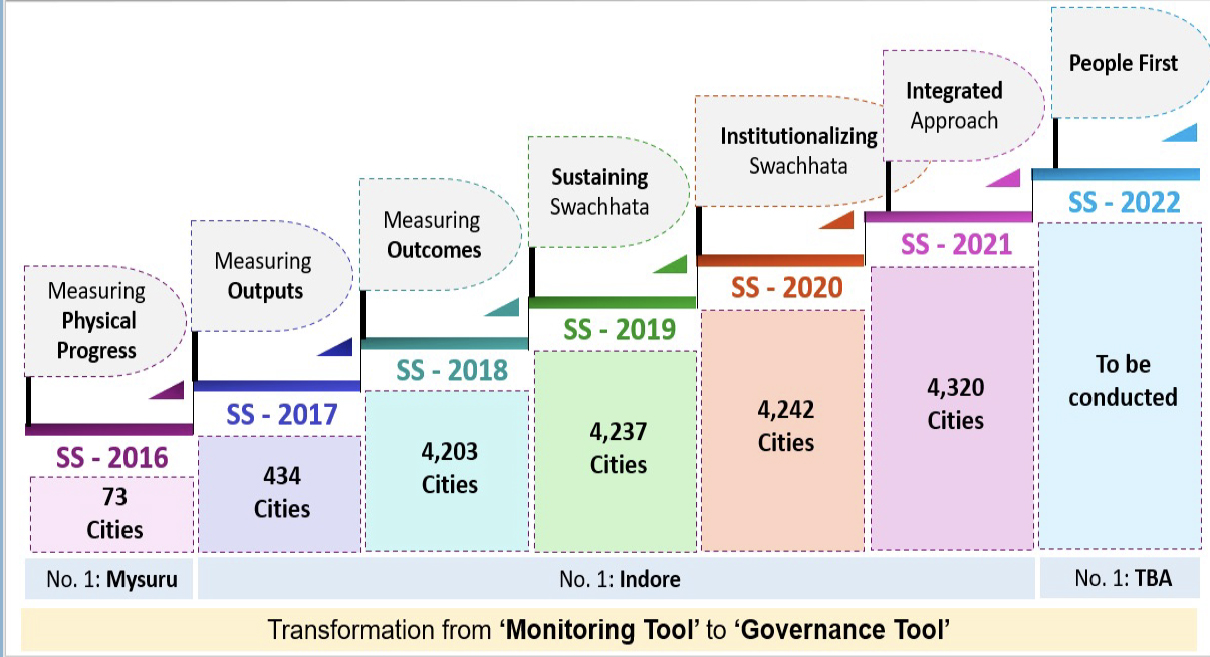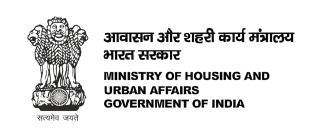At the start of the Mission in 2014, there was negligible progress on making cities ODF and solid waste processing was at just 18% in the urban areas. An accelerated approach was necessary to achieve Hon’ble Prime Minister’s vision of a Swachh Bharat within the timeframe of five years. A framework was therefore needed to bring about rigour in monitoring progress and inculcate a spirit of healthy competition amongst cities and States to improve their performance in key cleanliness parameters. This led to the conceptualization and implementation of Swachh Survekshan (SS), the annual cleanliness survey conducted by the Ministry of Housing & Urban Affairs (MoHUA) that has today taken shape of the largest urban sanitation survey in the world.
Designed as a competitive monitoring framework/ tool, Swachh Survekshan is one of the most effective tools for accelerating governance, helping India to achieve the goal of sustainable sanitation and waste management, while also transforming the way the Government of India works to achieve other key development goals. Through its multi-pronged data collection approach and robust assessment methodology, Swachh Survekshan has enthused cities with a healthy spirit of competition to improve the status of urban sanitation and ensure best service delivery to their citizens.
- i. Service level progress – evaluating progress of cities on ODF status, segregated waste collection, processing, disposal of solid waste and sustainable sanitation. Progress claimed is validated through interaction with citizens and on-field visits;
- ii. Citizens’ Voice - assessment of cities based on direct feedback, engagement with citizens; and
- iii. Certifications assessing progress of cities on their performance under Ministry’s certification protocols such as Star Rating for Garbage Free Cities and ODF/ODF+/ODF++/Water+.
- iv. An independent agency verifies the data and validates the progress of each city through on-call/ on-field interaction with citizens and randomly assesses areas in cities, while movement of assessors are geo-tagged.

The survey has been successful in enthusing cities with a spirit of healthy competition towards the concept of ‘swachhata’.In its first round in 2016, the ‘Swachh Survekshan’ was conducted among 73 cities with population of 10 lakh and above, and state / UT capitals of India, and had 1 lakh citizen providing feedback. In 2017, the survey was conducted among 434 cities, and 18 lakh citizen feedback was collected. Swachh Survekshan 2018 covered 4,203 ULBs: Indore, Bhopal and Chandigarh were adjudged the top 3 cleanest cities in the country, and Jharkhand, Maharashtra, and Chhattisgarh emerged as the top 3 performing states respectively. 37 lakh citizens provided their feedback. This survey, the first ever Pan India Sanitation Survey impacting around 40 crore people, was probably the largest such survey in the World. Swachh Survekshan 2019 covered 4,237 cities. Indore once again emerged as the Cleanest city in the country, with Ambikapur and Mysuru adjudged 2nd and 3rd cleanest respectively. Chhattisgarh, Jharkhand and Maharashtra emerged as the best performing states. The survey garnered 64 lakh citizens’ feedback. The SS 2019 was unique in that the service level assessment was completely online and paperless. Moreover, as against the three data points used in the previous surveys, the 2019 edition had a fourth data point – the third party certifications of cities (based on garbage free protocol, and ODF, SBM ODF+ and SBM ODF++ protocols introduced by MOHUA). Swachh Survekshan 2020 (SS 2020), which covered 4,242 cities, introduced the concept of ‘continuous Survekshan’ to ensure that the Mission outcomes are sustained through a system of continuous monitoring and verification. There were three rounds of quarterly Survekshan (Swachh Survekshan Leagues)

The Swachh Survekshan framework has evolved continuously – from being just a monitoring framework measuring outcomes, it has become an implementation accelerator enabling sustainability of outcomes by institutionalizing ‘Swachhata’. Swachh Survekshan has been able to significantly transform the urban governance mechanism by incorporating speed, scale and agility at its core. While the triangulated approach of the survey (service level progress, certifications and citizens’ voice) coupled with third party certifications has lent credibility to the assessment process, data from the survey has not only resulted in better decision making by government authorities but has helped them identify, address and solve sanitation and waste management issues in a time-bound manner. Added to this is the issue of optimum utilization of resources with cities being able to allocate and spend funds under the Mission to achieve targeted results. It is noteworthy that the performance of not just cities but city administrators such as Municipal Commissioners are linked directly to the ranking of cities in Swachh Survekshan thus becoming an effective ‘report card’ for the city and its leadership.
A key highlight under Swachh Survekshan has been the launch of the ‘Prerak DAUUR Samman’, a new award category based on performance of cities along 7 key parameters, which is sure to further enthuse cities to aspire towards higher levels of ‘Swachhata’. This Samman will be given to cities for five levels of achievement in Swachhata - Divya (Platinum), Anupam (Gold), Ujjwal (Silver), Udit (Bronze), Aarohi (Aspiring).
Swachh Survekshan is a framework which truly has unleashed agility in urban governance towards achieving social outcomes. This framework, with its roots in creating “peer pressure”, has the potential to transform governance in various other spheres through people’s active participation, agility and competitiveness.


